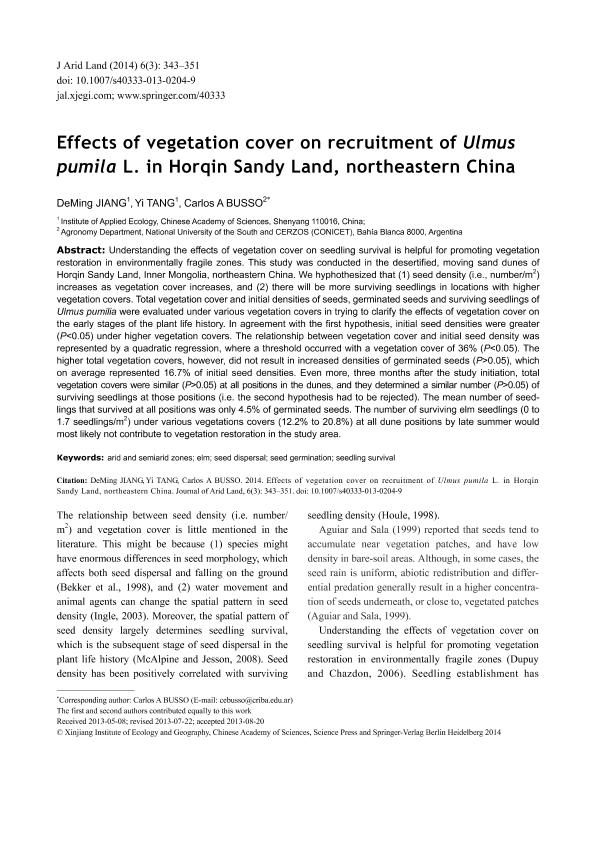Mostrar el registro sencillo del ítem
dc.contributor.author
Jiang, Deming
dc.contributor.author
Yi, Tang
dc.contributor.author
Busso, Carlos Alberto

dc.date.available
2017-01-16T19:56:42Z
dc.date.issued
2014-06
dc.identifier.citation
Jiang, Deming ; Yi, Tang ; Busso, Carlos Alberto; Effects of vegetation cover on recruitment of Ulmus pumila L. in Horqin Sandy Land, northern China; Springer; Journal of Arid Land; 6; 3; 6-2014; 343-351
dc.identifier.issn
1674-6767
dc.identifier.uri
http://hdl.handle.net/11336/11423
dc.description.abstract
Understanding the effects of vegetation cover on seedling survival is helpful for promoting vegetation restoration in environmentally fragile zones. This study was conducted in the desertified, moving sand dunes of Horqin Sandy Land, Inner Mongolia, northeastern China. We hyphothesized that (1) seed density (i.e., number/m2) increases as vegetation cover increases, and (2) there will be more surviving seedlings in locations with higher vegetation covers. Total vegetation cover and initial densities of seeds, germinated seeds and surviving seedlings of Ulmus pumilia were evaluated under various vegetation covers in trying to clarify the effects of vegetation cover on the early stages of the plant life history. In agreement with the first hypothesis, initial seed densities were greater (P<0.05) under higher vegetation covers. The relationship between vegetation cover and initial seed density was represented by a quadratic regression, where a threshold occurred with a vegetation cover of 36% (P<0.05). The higher total vegetation covers, however, did not result in increased densities of germinated seeds (P>0.05), which on average represented 16.7% of initial seed densities. Even more, three months after the study initiation, total vegetation covers were similar (P>0.05) at all positions in the dunes, and they determined a similar number (P>0.05) of surviving seedlings at those positions (i.e. the second hypothesis had to be rejected). The mean number of seedlings that survived at all positions was only 4.5% of germinated seeds. The number of surviving elm seedlings (0 to 1.7 seedlings/m2) under various vegetations covers (12.2% to 20.8%) at all dune positions by late summer would most likely not contribute to vegetation restoration in the study area.
dc.format
application/pdf
dc.language.iso
eng
dc.publisher
Springer

dc.rights
info:eu-repo/semantics/openAccess
dc.rights.uri
https://creativecommons.org/licenses/by-nc-sa/2.5/ar/
dc.subject
Arid And Semiarid Zones
dc.subject
Elm
dc.subject
Seed Dispersal
dc.subject
Seed Germination
dc.subject
Seedling Survival
dc.subject.classification
Ecología

dc.subject.classification
Ciencias Biológicas

dc.subject.classification
CIENCIAS NATURALES Y EXACTAS

dc.title
Effects of vegetation cover on recruitment of Ulmus pumila L. in Horqin Sandy Land, northern China
dc.type
info:eu-repo/semantics/article
dc.type
info:ar-repo/semantics/artículo
dc.type
info:eu-repo/semantics/publishedVersion
dc.date.updated
2017-01-13T19:20:11Z
dc.identifier.eissn
2194-7783
dc.journal.volume
6
dc.journal.number
3
dc.journal.pagination
343-351
dc.journal.pais
China

dc.description.fil
Fil: Jiang, Deming . Chinese Academy of Sciences. Institute of Applied Ecology; China
dc.description.fil
Fil: Yi, Tang . Chinese Academy of Sciences. Institute of Applied Ecology; China
dc.description.fil
Fil: Busso, Carlos Alberto. Universidad Nacional del Sur. Departamento de Agronomía; Argentina. Consejo Nacional de Investigaciones Científicas y Técnicas. Centro Científico Tecnológico Bahía Blanca. Centro de Recursos Naturales Renovables de la Zona Semiárida(i); Argentina
dc.journal.title
Journal of Arid Land
dc.relation.alternativeid
info:eu-repo/semantics/altIdentifier/url/http://link.springer.com/article/10.1007/s40333-013-0204-9
dc.relation.alternativeid
info:eu-repo/semantics/altIdentifier/doi/http://dx.doi.org/10.1007/s40333-013-0204-9
Archivos asociados
